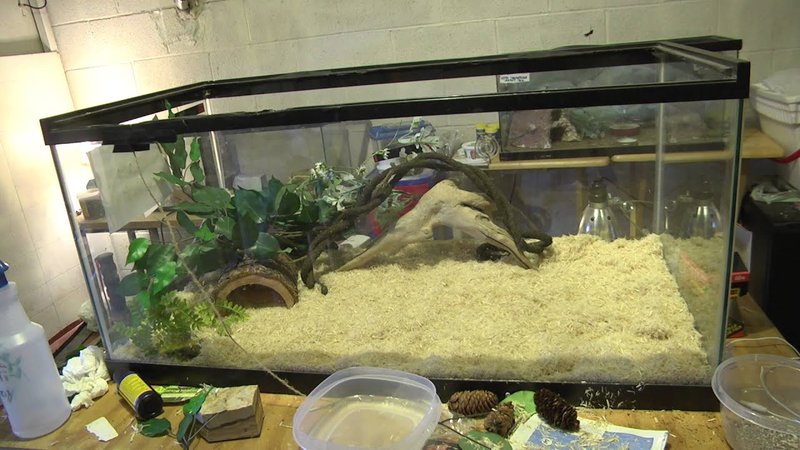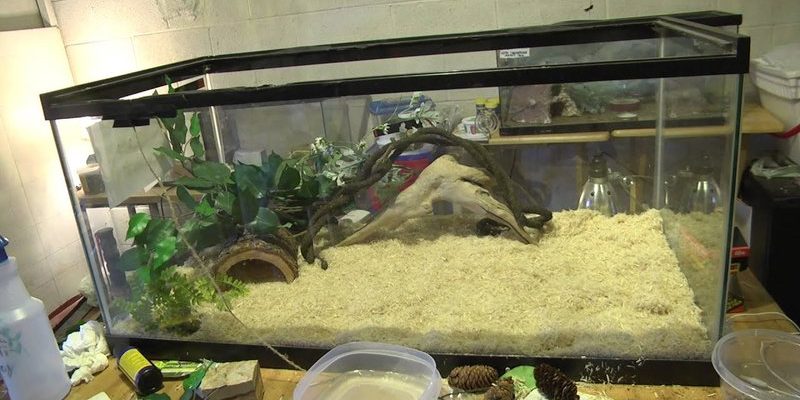
Now, think of your corn snake’s enclosure as their whole world. Just like we need a good mix of comfort and functionality in our homes, your snake needs an enclosure that meets their specific needs. This includes the right size, heat sources, and the right substrate to make them feel secure. Let’s explore what you need to create an ideal setup that keeps your corn snake happy and healthy.
The Right Size for Your Corn Snake’s Enclosure
When it comes to choosing an enclosure, size really does matter. Corn snakes can grow quite a bit, usually reaching lengths of 3 to 5 feet. For a baby corn snake, a 20-gallon aquarium is a great start, but you’ll need to upgrade as they grow. Ideally, a full-grown corn snake will need at least a 40-gallon tank to have enough room to stretch out and explore.
Here’s the thing: a bigger tank isn’t just about more space; it’s also about mental stimulation. A spacious environment encourages your snake to exercise, roam, and exhibit natural behaviors. Make sure the tank is at least 2/3 of the snake’s length for them to get a good amount of space without feeling overwhelmed.
If you’re considering a more long-term setup, a tub system can be a great alternative. These are typically easier to manage in terms of heating and humidity, plus they can often be more affordable. Just keep in mind that whatever you choose, it should provide enough height for climbing and a secure lid to prevent escapes!
Heating Your Corn Snake’s Enclosure
Heating is a vital component of your corn snake’s enclosure because it helps them regulate their body temperature. Snakes, being ectothermic, rely on external heat sources to warm up. You need to create a temperature gradient in the tank. This means having a warm side and a cool side.
For the warm side, aim for a temperature between 80°F to 85°F (27°C to 29°C). You can achieve this with a heat mat placed under the tank or a heat lamp. Just be cautious with heat lamps; they can dry out the enclosure if left on too long. On the cool side, keep it around 70°F to 75°F (21°C to 24°C), giving your snake a choice to regulate their temperature as they wish.
Don’t forget to monitor the temperatures with a reliable thermometer! It’s crucial to ensure your snake is comfortable and safe. If the heat levels fluctuate too much, it can lead to stress or health issues, so invest in a good digital thermometer for accurate readings.
Choosing the Best Substrate
Substrate is about more than just looks; it plays a crucial role in your corn snake’s health and comfort. The right substrate helps with humidity control, is easy to clean, and provides a natural feel. Some popular choices include aspen shavings, cypress mulch, and newspaper. Let’s break these down a bit.
Aspen shavings are a common choice. They’re soft, absorb moisture well, and allow for easy burrowing. This substrate is great for giving your snake a natural feel. However, avoid cedar or pine shavings as they can be harmful to snakes.
Cypress mulch is another excellent option. It retains humidity well, which is beneficial, especially during shedding. This type of substrate also looks more natural, making your tank aesthetically pleasing.
For an easy cleanup, many snake owners opt for newspaper or paper towels. They don’t look as nice but offer a simple way to maintain the enclosure since you can just toss them out and replace them easily.
Decor and Hiding Spots
A corn snake needs spaces to hide and explore, just like we need our own little corners in our homes. Adding hiding spots in their enclosure helps your snake feel secure and reduces stress. You can use commercial hides or create your own using cardboard boxes or logs.
Consider incorporating various structures to keep things interesting. Branches for climbing can add vertical space, and rocks can give your snake something to rub against while shedding. Always ensure that the decor is free of sharp edges to prevent any injuries.
Also, make sure to vary the sizes of the hiding spots. Your snake will appreciate having options that fit snugly for when they need a quiet moment and larger spaces for exploring and lounging.
Humidity Levels and Water Needs
Humidity plays a significant role in a corn snake’s health, especially when it comes time to shed. Ideally, you want to keep humidity levels between 40% and 60%. If the air is too dry, it can lead to shedding issues. Conversely, too much humidity can lead to respiratory problems.
To help manage humidity, consider using a water dish that’s large enough for your snake to soak in. This can help them during shedding and also gives them a fun way to cool down. When choosing a water bowl, make sure it’s heavy enough that your snake can’t tip it over easily.
If you find that your enclosure is too dry, misting the substrate lightly or adding a small humidity gauge can help you monitor the levels. A moist hide made from a damp sponge or paper towels can also provide a humid retreat for shedding.
Additional Considerations for Your Enclosure Setup
Creating the best corn snake enclosure goes beyond just size, heat, and substrate. Think about the entire environment your snake will experience. Regular cleaning is vital, as a dirty tank can harbor harmful bacteria. Change the substrate as needed and clean decorations with mild soap and water.
Lighting is another overlooked aspect. While corn snakes don’t require UVB lighting, having a light on for about 12 hours a day can mimic natural day/night cycles. This not only helps regulate their behavior but also enhances the beauty of the enclosure.
Lastly, consider how often you’ll be handling your snake. A calm, stress-free environment will help your corn snake feel more comfortable being taken out for interaction. Spend time observing them in their home, and over time, they’ll start to recognize you as a familiar face.
Closing Thoughts
Setting up your corn snake’s enclosure might feel overwhelming at first, but by focusing on size, heat, substrate, and the overall environment, you’ll create a thriving space for your snake. Remember, it’s about making them feel secure and happy in their new home. Just like any good house, keep it clean, comfortable, and inviting, and your corn snake will thrive!

